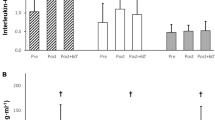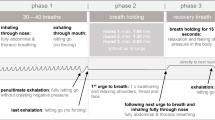Abstract
Cold immersion evokes the life-threatening cold shock response (CSR). We hypothesised that anxiety may increase the magnitude of (Study 1), and diminish habituation to (Study 2), the CSR. Study 1: eleven participants completed two 7-min immersions in cold water (15 °C). On one occasion, to induce anxiety, participants were instructed that the water would be 5 °C colder (ANX); it was unchanged. The other immersion was a control (CON). Study 2: ten different participants completed seven, 7-min immersions. Immersions 1–5 induced habituation. Immersions 6 and 7 were counter-balanced to produce anxiety (ANX) or acted as a control (CON). Anxiety (20 cm scale) and cardiorespiratory responses (cardiac frequency [f c]), respiratory frequency [f R], tidal volume [VT], minute ventilation [\( \dot{V}_{\text{E}} \)]) were measured in both studies. Results of study 1: participants were more anxious in the ANX immersion (mean [SD]; CON 5.3 [3.6] and ANX 8.4 [5.0] cm). f c peaked at higher levels in ANX (136.4 [15.0]; CON: 124.0 [17.6] b min−1) and was higher pre-immersion and in minutes 3 and 5–7 by 7.2 [2.1] b min−1. ANX \( \dot{V}_{\text{E}} \) was higher pre immersion and in minutes 5–6. Results of study 2: repeated immersion habituated the CSR. Anxiety was greater prior to ANX (CON 1.9 [2.3], ANX 6.6 [4.8] cm). f c in ANX was higher prior to immersion and in minutes 1–2, 4–6 cf CON; ANX f c was not different to the CSR seen in pre-habituation. f R was higher in minute 1 of immersion 1 (cf min 1 CON and ANX) following which it exceeded the CSR in CON. The magnitude and duration of CSR (f c, \( \dot{V}_{\text{E}} \)) increased with anxiety. Anxiety diminishes CSR habituation.




Similar content being viewed by others
References
Barwood MJ, Dalzell J, Datta A, Thelwell R, Tipton MJ (2006) Breath-hold performance during cold water immersion: effects of psychological skills training. Aviat Space Environ Med 77:1136–1142
Barwood MJ, Datta A, Thelwell R, Tipton MJ (2007) Breath-hold performance during cold water immersion: effects of habituation with psychological training. Aviat Space Environ Med 78:1029–1034
Brooks CJ, Gibbs PN, Jenkins JL, McLoed S (2007) Desensitizing a pilot with a phobic response to required helicopter underwater escape training. Aviat Space Environ Med 78:618–623
Cella DF, Perry SW (1986) Reliability and concurrent validity of three visual-analogue mood scales. Psychol Rep 59:827–833
Dampney RAL, Horiuichi J, McDowall LM (2008) Hypothalamic mechanisms coordinating cardiorespiratory function during exercise and defensive behaviour. Auton Neurosci Basic 142:3–10
Datta AK, Tipton MJ (2006) Respiratory responses to cold water immersion: neural pathways, interactions, and clinical consequences awake and asleep. J Appl Physiol 100:2057–2064
Davis M (1992) The role of the amygdala in conditioned fear. In: Aggleton J (ed) The amygdala: neurobiological aspects of emotion, memory and mental dysfunction. Wiley Liss, New York, pp 255–306
Fontes MAP, Xavier CH, de Menezes RCA, Dimicco JA (2011) The dorsomedial hypothalamus and central pathways involved in the cardiovascular response to emotional stress. Neurosci 184:64–74
Glaser EM, Griffin JP (1962) Influence of the cerebral cortex on habituation. J Physiol 160:429–445
Glaser EM, Hall MS, Whittow GC (1959) Habituation to heating and cooling of the same hand. J Physiol 146:152–164
Goode RC, Duffin J, Miller R, Romet TT, Chant W, Ackles A (1975) Sudden cold water immersion. Respir Physiol 23:301–310
Griffin JP (1963) The role of the frontal areas of the cortex on habituation in man. Clin Sci 24:127–134
Grossman P (1983) Respiration, stress, and cardiovascular function. Psychophysiology 20:284–300
Holliday NP, Kennedy J, Kent EC, Marsh R, Sherwin T, Berry, DI (2007–2008) Marine climate change impacts partnership Scientific review—sea temperature (MCCIP annual
Jay O, Christensen JP, White MD (2007) Human face-only immersion reduces maximal apnoeic times and stimulates ventilation. Exp Physiol 92:197–206
LaMotte RH, Campbell JN (1978) Comparison of responses of warm and nociceptive C-fiber afferents in monkeys with human judgments of thermal pain. J Neurophysiol 41:509–528
Lunt HC, Barwood MJ, Corbett J, Tipton MJ (2010) “Cross-adaptation” habituation to short repeated cold-water immersions affects the response to hypoxia in humans. J Physiol 588:3605–3613
Modell JH, Gaub M, Moya F, Vestal B, Swarz H (1966) Physiologic effects of near drowning with chlorinated fresh water, distilled water and isotonic saline. Anaesthesiology 27(1):33–41
Noteboom JT, Fleshner M, Enoka RM (2001a) Activation of the arousal response can impair performance in a simple motor task. J Appl Physiol 91:821–831
Noteboom JT, Barnholt KR, Enoka RM (2001b) Activation of the arousal response and impairment of performance increase with anxiety and stressor intensity. J Appl Physiol 91:2093–2101
Tipton MJ (1989) The initial responses to cold-water immersion in man. Clin Sci 77:581–588
Tipton MJ (1995) Immersion fatalities: hazardous responses and dangerous discrepancies. J Royal Nav Med Serv 81:101–107
Tipton MJ (2003) Cold water immersion: sudden death and prolonged survival. Lancet 362:12–13
Tipton MJ, Stubbs DA, Elliott DH (1991) Human initial responses to immersion in cold water at three temperatures and after hyperventilation. J Appl Physiol 70(1):317–322
Tipton MJ, Eglin CM, Golden FStC (1998a) Habituation of the initial responses to cold water immersion in humans: a central or peripheral mechanism? J Physiol 512:621–628
Tipton MJ, Golden FS, Higenbottam C, Mekjavic IB, Eglin CM (1998b) Temperature dependence of habituation of the initial responses to cold water immersion. Eur J Appl Physiol Occup Physiol 78:253–257
Tipton MJ, Mekjavic IB, Eglin CM (2000) Permanence of the habituation of the initial responses to cold-water immersion in humans. Eur J Appl Physiol 83:17–21
Tipton MJ, Gibbs P, Brooks C, Roiz de Sa D, Reilly T (2010) ECG during helicopter underwater escape training. Aviat Space Environ Med 78(81):399–404
Tye KM, Prakash R, Kim SY, Fenno LE, Grosenick L, Zarabi H, Thompson KR, Gradinura V, Ramakrishnan C, Deisseroth K (2011) Amygdala circuitry mediating reversible and bidirectional control of anxiety. Nature 471:358–362
Winters RW, McCabe PM, Green EJ, Schneiderman N (2000) Stress responses, coping and cardiovascular neurobiology: central nervous system circuitry underlying learned and unlearned affective responses to stressful stimuli. In: McCabe PM, Schneiderman N, Field T, Wellens R (eds) Stress, coping and cardiovascular disease. Erlbaum, Mahwah, pp 1–48
Zald DH (2003) The human amygdala and the emotional evaluation of sensory stimuli. Brain Res Rev 41:88–123
Acknowledgments
The authors wish to thank the participants for their reliability and forbearance and the technical support staff who worked on this project.
Author information
Authors and Affiliations
Corresponding author
Additional information
Communicated by George Havenith.
Rights and permissions
About this article
Cite this article
Barwood, M.J., Corbett, J., Green, R. et al. Acute anxiety increases the magnitude of the cold shock response before and after habituation. Eur J Appl Physiol 113, 681–689 (2013). https://doi.org/10.1007/s00421-012-2473-y
Received:
Accepted:
Published:
Issue Date:
DOI: https://doi.org/10.1007/s00421-012-2473-y




